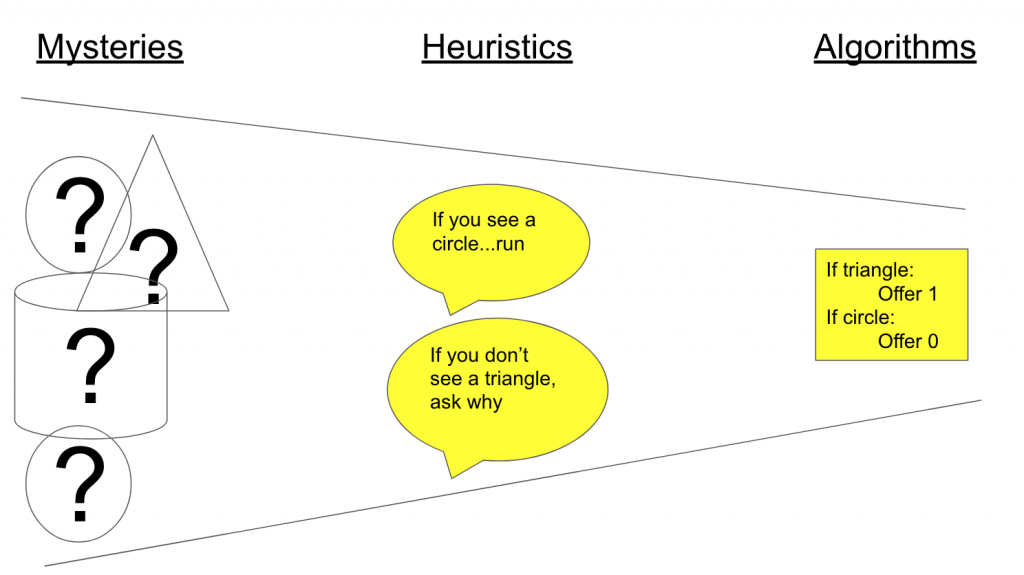The Rate of Forgetting
What if the rate of forgetting is interrelated with the rate of learning?
What might that mean?
The Knowledge Funnel
The Knowledge Funnel is a model that describes how knowledge is made useful by an organization. At one side, you got mysteries. We live in an era where the number of mysteries vastly outnumbers the amount of knowledge. There is no shortage of mystery. Heuristics are rules of thumb that work most of the time, but not all of the time. There are lot of heuristics. They tend to form the core value driver for many organizations. There are comparatively fewer algorithms. Those organizations that have fit algorithms are often extraordinarily profitable and competitive. Some researchers focus on converting mysteries into heuristics. Data scientists focus on converting heuristics into algorithms. There are different mechanical processes and workflows for each.

Rate Of Learning
Going from mystery to heuristic, and heuristic to algorithm, can be described by a rate. There are natural limits to how many mysteries are demystified, and how many heuristics are converted to algorithms. There are many factors that limit that rate.
Like your brain. Your brain has a certain carrying capacity for thought. I don’t know how many words we think a day. Maybe we think faster than we talk? There is some upward, finite, bound for how much thought you can have.
The number of exploration cycles available to a firm vary by capitalization and culture. Some firms are so focused on execution that there are no cycles left over for discovery. When all the energy is going towards just keeping the lights on, there is nothing left over for improving the lighting. Future profit margins almost always depend on discovery. Some organizations are prolific in working the knowledge funnel. Many are not.
What if forgetting is a rate limiter?
The Role of Forgetting in Learning: A Story
Assume a heuristic that is used by a community within an organization. How about a heuristic that the font Carlito is the best font of all time? It’s great for headlines, navigation, copy, iconography, footers — really, everywhere. It’s all about Carlito.
Just assume that the belief was formed years ago, but nobody remembers why. It has always been done that way.
One day, a new hire, an outsider joining the community, Gamon, decides to make something using Glacial Indifference font. It makes it into production.
Somebody notices. Gamon is confronted.
“Who gave you permission to use that font?”
Gamon is confused. “Permission?”
Somebody overhears the conflict and helps reframe.
“What I think they’re asking, Gamon, is what font did you use, and what was your inspiration?”
Gamon explains the intuition.
“Hold on, why are we locked into Carlito?” somebody asks.
And nobody can remember.
Because nobody can remember, a discussion about the heuristic of a specific font is opened up. A forgotten justification makes it easier to have a discussion.
The community is at least able to learn about the effect of other fonts. They’re free to explore new mysteries at the top of the funnel.
The knowledge funnel is unplugged.
Forgetting
Thomas Kuhn (1962) suggested that scientific communities had hard times of letting go. He took a lot of grief. Lots of clenched fists and angry denials. They didn’t want to believe that their knowledge funnel could get jammed up. I don’t know if there was ever acceptance of Scientific Revolutions in the hard sciences. I accepted it. And took the warning seriously. Evidently.
Organizational memory is more encoded in behaviour and language, culture, than it is in hard documentation. Heuristics are often prized. They’re often prized to the point of being hidden knowledge. Hidden knowledge is kept from the organization, but retained by individuals or communities within the organization.
Because heuristics are prized, they’re harder to let go. They’re harder to forget. And, unlike scientific communities where finding are peer reviewed and published for all to see, hidden heuristics are hidden. This can make learning especially challenging, especially if people are unwilling to share the reason or logic for their decisions.
There is a distinction between forgetting and unlearning. It’s perfectly possible to unlearn a heuristic and let it go. It’s much easier to let go when it’s just forgotten.
Forgetting is so much easier than unlearning.
The Rate of Forgetting
How quickly can an individual, a community, an organization – forget?
Staff churn may be one indicator. The heuristic that 15% turnover is regarded as healthy because it lets enough new people with new ideas to enter the firm exists. What of the effect of the knowledge that that those people are taking with them when they leave?
Self-censoring may be another factor. What happens when people stop sharing memories with others? What happens when they remain silent about it? The line between sharing wisdom and reinforcing a heuristic can be tough to hear. There’s a big difference between a stance that we already tried that, and it failed, so don’t try again, and one of, let’s try doing it differently this time.
The rate at which individuals are liberated from their teams for periods of time may be another one. What happens when people with no memory of a heuristic are liberated from a team culture that treats it as dogma? What might they learn?
What if the rate of forgetting is interrelated with the rate of learning?
What Might It Mean?
Why should it be the case that forgetting is easier, safer, than unlearning?
Why all the fear?
The answer to is contextual. It depends on individuals and the cultures that shape their behaviour.
The answer, in your context, is likely to be far more useful than anything else.
